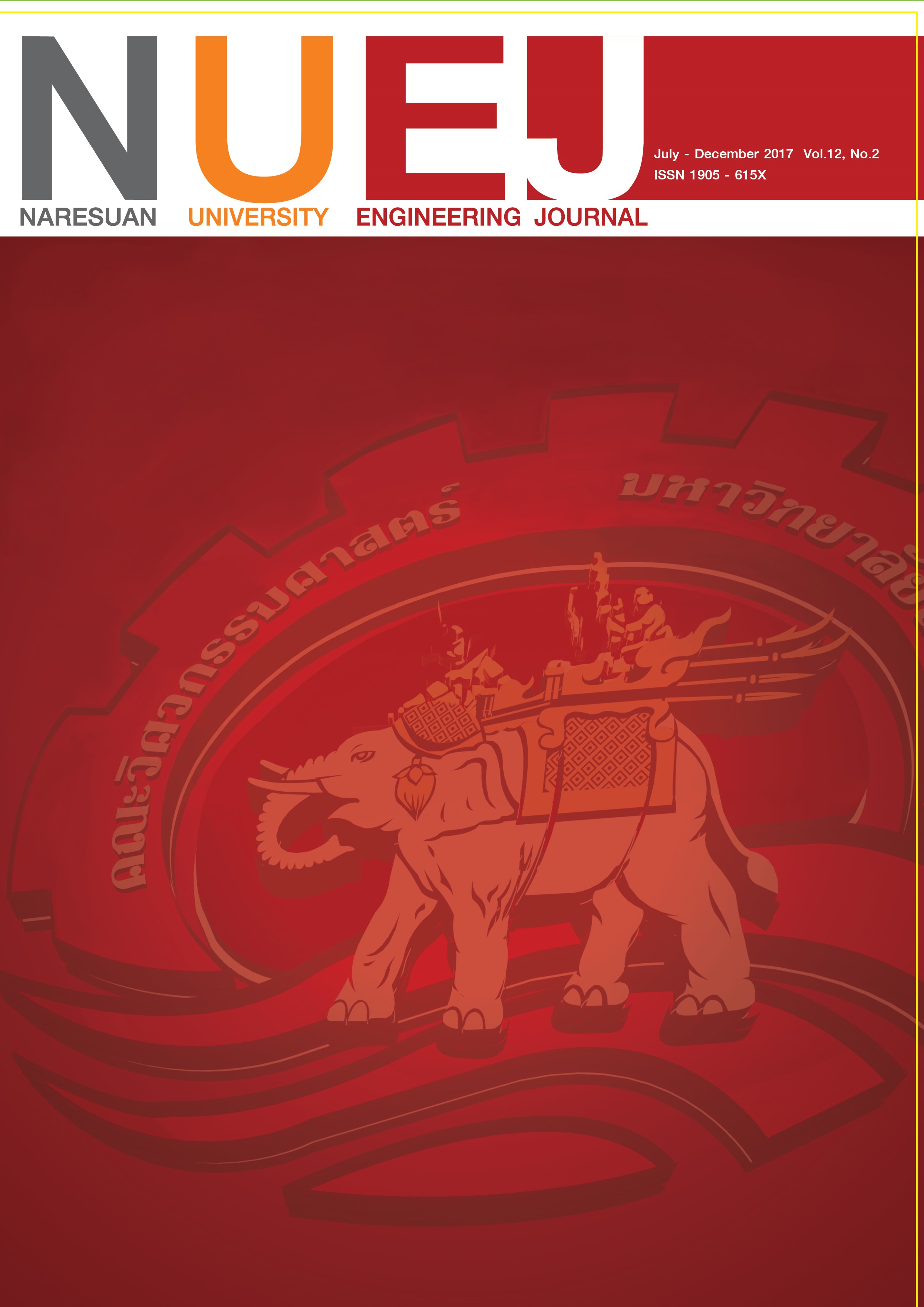Adiabatic Temperature Change of Gadolinium Modeling using Artificial Neural Network
Main Article Content
Abstract
An adiabatic temperature change of magnetocaloric material is an important parameter required in an active magnetic regenerator modeling. In this study, the adiabatic temperature change of Gadolinium was modeled by using artificial neural network. The adiabatic temperature changes were found at different magnetic inductions and magnetic material temperatures by means of WDS (Weiss-Debye-Sommerfeld) method. These data were applied to train a multilayer neural network with backpropagation algorithm. Artificial neural network with one hidden layer was chosen and the number of neurons was varied in training process until its mean square error (MSE) is lower than 10-6. From the training result, the optimum number of neurons in the hidden layer is 16. Untrained data were used to test the optimum structure. It is found that MSE of testing is 4.4610-5. The weights and biases obtained from the optimum structure were used to model the adiabatic temperature change. Finally, an example code for the adiabatic temperature change calculation based on the weights and biases was presented as a guide for application.
Article Details
References
Gschneidner, K.A., & Pecharsky, K.V. (2008). Thirty years of near room temperature magnetic cooling: Where we are today and future prospects. International Journal of Refrigeration, 31(6), 945–961.
Brown, G.V. (1976). Magnetic heat pumping near room temperature. Journal of Applied Physics, 47, 3673–3680.
Yu, B., Liu, M., Egolf, P.W., & Kitanovski, A. (2010). A review of magnetic refrigerator and heat pump prototypes built before the year 2010. International Journal of Refrigeration, 33(6), 1029-1066.
Lei, T., Engelbrecht, K., Nielsen, K.K., & Veje, C.T. (2017). Study of geometries of active magnetic regenerators for room temperature magnetocaloric refrigeration. Applied Thermal Engineering, 111(25), 1232–1243.
Torregrosa-Jaime, B., Corberan, J. M., Paya, J., & Engelbrecht, K. (2015). An efficient numerical scheme for the simulation of parallel-plate active magnetic regenerators. International Journal of Refrigeration, 58, 121-130.
Siddikov, B.M., Wade, B.A., & Schultz, D.H. (2005). Numerical simulation of the active magnetic regenerator. Computers and Mathematics with Applications, 49(9-10), 1525-1538.
Engelbrecht, K.L., Nellis, G.F., & Klein, S.A. (2006). Predicting the performance of an active magnetic regenerator used of space cooling and refrigeration. HVAC & Research, 2(4), 1077-1095.
Aprea, C., & Maiorinoi, A. (2010). A flexible numerical model to study an active magnetic refrigerator for near room temperature applications. Applied Energy, 87(8), 2690-2698.
Nielsen, K.K., Tusek, J., Engelbrecht, K., Schopfer, S., Kitanovski, A., Bahl, C.R.H., Smith, A., Pryds, N., & Poredos, A. (2011). Review on numerical modeling of active magnetic regenerators for room temperature applications. International Journal of Refrigeration, 34(3), 603-616.
Li, J., Numazawa, T., Nakagome, H., & Matsumoto, K. (2011). Numerical modeling on a reciprocating active regenerator refrigeration in room temperature. Cryogenics, 51(6) 347-352.
Park, I., Kim, Y., & Jeong, S. (2013). Development of the tandem reciprocating magnetic regenerative refrigerator and numerical simulation for the dead volume effect. International Journal of Refrigeration, 36(6), 1741-1749.
Trevizoli, P.V., Barbosa, J.R., Tura, A., Arnold, D., & Rowe, A. (2014). Modeling of thermomagnetic phenomena in active magnetocaloric regenerators. Journal of Thermal Science and Engineering Applications, 6(3), 0310161- 03101610.
You, Y., Yu, S., Tian, Y., Luo, X., & Huang, S. (2016) A numerical study on the unsteady heat transfer in active regenerator with multi-layer refrigerants of rotary magnetic refrigerator near room temperature. International Journal of Refrigeration, 65, 238-249.
Tusek, J., Kitanovski, A., Zupan, S., Prebil, I., & Poredo, A. (2013). A comprehensive experimental analysis of gadolinium active magnetic regenerators. Applied Thermal Engineering, 53(1), 57-66.
Kamran, M.S., Sun, J., Tang, Y.B., Chen, Y.G., Wu, J.H., & Wang, H.S. (2016). Numerical investigation of room temperature magnetic refrigerator using microchannel regenerators. Applied Thermal Engineering, 102(5), 1126- 1140.
Bhattacharjee, D., & Kothari, V., (2007). A neural network system for prediction of thermal resistance of textile fabrics. Textile Research Journal, 77(1), 4-12.
Esfe, M.H., Wonswises, S., Naderi, A., Asadi, A., Safaei, M.R., Rostamian, H., Dahari, M., & Karimipour, A. (2015). Thermal conductivity of Cu/TiO2-Water/EG hybrid nanofluid: Experimental data and modeling using artificial neural network and correlation. International Communications in Heat and Mass Transfer, 66, 100-104.
Singh, R., Bhoopal, R.S., & Kumar, S., (2011). Prediction of effective thermal conductivity of moist porous materials using artificial neural network approach. Building and Environment, 46(12), 2603-2608.
Pecharsky, K.V., & Gschneidner, K.A. (1999). Magnetocaloric effect and magnetic refrigeration. Journal of Magnetism and Magnetic Materials, 200(1–3), 44-56.
Tishi, A.M. (1990). Magnetocaloric effect in strong magnetic fields. Cryogenics, 30(2), 127-136.
de Oliveira, N.A., von Ranke, P.J., & Troper, A. (2014). Magnetocaloric and barocaloric effects: theoretical description and trends. International Journal of Refrigeration, 37, 237-248.
Callen, H.B. (1960). Thermodynamics: an introduction to the physical theories of equilibrium thermostatics and irreversible thermodynamics. Singapore: John Wiley & Son.
Kittel, C. (2005). Introduction to solid state physics. (8th ed.). USA: John Wiley & Sons.
Ashcroft, N.W., & Mermin, N.D. (1976). Solid state physics. USA: Harcourt Brace College Publishing.
Chapra, S.C., (2005). Applied numerical methods with MATLAB for engineers and scientists. Singapore: McGraw Hill.
Pertersen, T.F. (2007). Numerical modelling and analysis of a room temperature magnetic refrigeration system. (Ph.D. Thesis, The Technical University of Denmark).
Yui, K. (2015). Development of a magnetocaloric heat circulator based on self-heat recuperation technology. (Ph.D. Thesis, University of Tokyo).
Christodoulou, C., & Georgiopoulos, M. (2001). Applications of neural networks in electromagnetics. USA: Artech House.
Azizi, S., Ahmadloo, E., & Awad, M.M. (2016). Prediction of void fraction for gas-liquid flow in horizontal, upward and downward inclined pipes using artificial neural network. International Journal of Multiphase Flow, 87, 35-44.
Hagen, M.T., Demuth, H.B., & Beale, M. (1996). Neural network design. Boston, USA: PWS Publishing Company.
Liu, N., Yang, H., Li, H., Yan, S., Zhang, H., & Tang, W. (2015). BP artificial neural network modeling for accurate radius prediction and application in increment in-plane bending. The International Journal of Advanced Manufacturing Technology, 80(5), 971-984.

